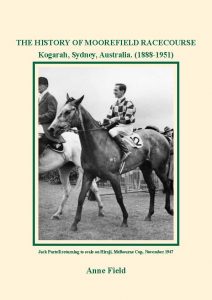It would be fitting if a documentary could be made on Moorefield Racecourse, Kogarah. (1888-1951) Moorefield is one of those Sydney Racecourses that have disappeared. My book has, I believe, brought the subject to life.
There are not many participants from Moorefield Racecourse alive today. We need to capture these people on film now.
Anne Field
ko77582@bigpond.net.au
Article (June 2018):
From the Collection “The History of Moorefield Racecourse, Kogarah, Sydney, Australia (1888 – 1951)” by Anne Field, Kaligraphic Print Pty Ltd, 2016

Exploring the collection reveals the variety of items and materials considered part of the wider story. While the physical objects and artwork can sometimes be the more ‘interesting’ parts, these pieces can only be given interest and context through the textual parts of the collection: the archives and the library. This issue, Racing through Time explores a book from the library. “The History of Moorefield Racecourse” was written by Anne Field, a Social Science teacher and former councillor, the book was the result of many, many years of research and conversations and a love of both horse racing and local history. What started as a promise to record the memories of one of the people in her council area, developed into a much deeper exploration. Moorefield Racecourse was positioned near Kogarah station and is now the site of James Cook Boys Technological High School and Moorefield Girls High School. First used as a racecourse in 1888 it was a focal point for the area until the last race in 1951. The book explores different aspects of the course through a series of nine chapters. Each chapter is built around quotes from people involved in the sport of Kings. The details of the race meetings reveal some well-known names, including Hiraji, winner of the Melbourne Cup in 1947 who was trained by Moorefield trainer Jim McCurley. Meticulously researched, the book uses newspapers, local archives and individual testimony to build up a story around a course that is no longer there. Continuing the memory of the area, it ends with Anne’s own reflection on her connection with the course and her lengthy research process.
Courtesy of Hannah Hibbert Archivist at Heritage, Australian Turf Cub
